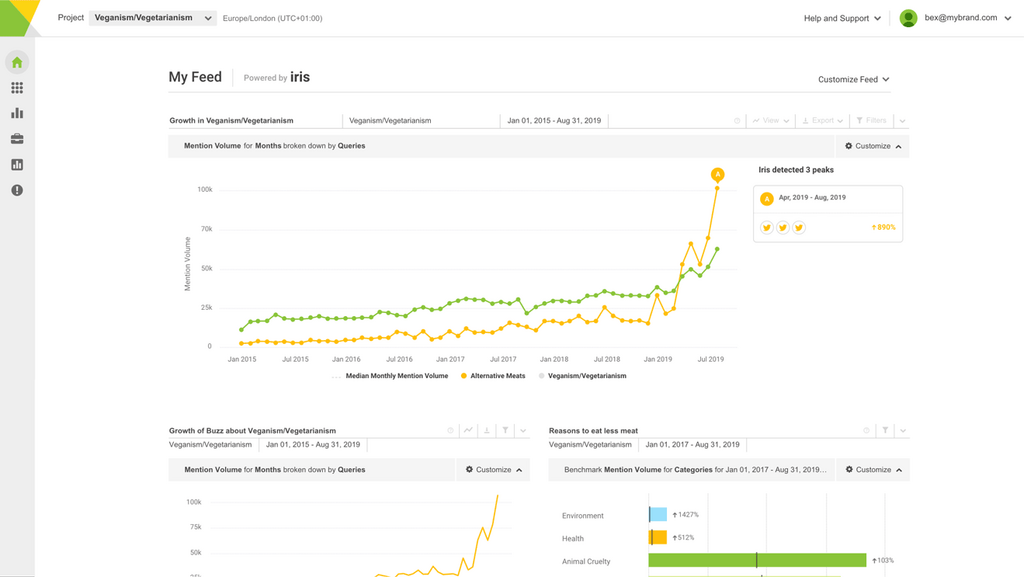10 Social Listening Tools and Who They’re Best for
By BrandwatchJul 14
Join us and boost your social media potential with our data-led event
Published May 10th 2018
On the internet, and particularly on social media, anyone and everyone can talk about your brand and reach a huge audience. Whether its a celeb bigging up your product or a tweeted complaint going viral, you never know what the day will bring. Brand monitoring is the solution for keeping on top of this.
Brand monitoring is the process of monitoring various channels to find mentions of your brand and assessing what is being said about it. This could include a newspaper article about a merger or complaints on social media.
The purpose is ultimately to be able to respond and act on these mentions. It can help you jump on good publicity or spot a crisis before it becomes a crisis (check out our blog on crisis management for more details on that). It’s also great for getting info on how your products are viewed and talked about.
Essentially you want to monitor as many places as possible. Whether you’re a tiny business or a multinational one, more and more people are finding their online voices. With smart phones, they could be talking about your brand even while they’re in your shop. Communication moves much faster now and you need to keep up.
Here’s a few key channels and areas:
Obviously you want to track mentions of your brand for brand monitoring, but there are other areas to consider as well. People won’t always talk directly about you and general industry talk can have a secondary effect on your business.
So, here are a few main things to track:
Little explanation is needed here, but making sure you know when people are talking about your company and its products is obviously essential for brand monitoring. This will give you lots of direct mentions and, more often than not, these can be the most important.
Got any well-known employees who are influential in your field? Make sure you’re monitoring conversations around them. The same goes for any C-level people in your business. Generally you’ll be hoping to pull in lots of nice publicity about how great they are, but it’s also handy if any negative stories are bubbling away.
It’s very easy for someone to refer to another website without mentioning its brand name, like we just did there with Buzzsumo. If you’re not tracking inbound links to your site then you could be missing a lot of references, good or bad, to your company. That’s not to mention the SEO benefit of keeping on top of these.
Conversations within your industry are important. If the new hot thing is something you don’t do, that could damage your brand even if you’re not mentioned. Beyond your industry, looking at related terms in the wider press is important too. A crisis, for example, can cause damage by association. If there’s a big controversy involving similar businesses to yours, people might start wondering about you too.
There are a load of tools out there for this purpose and we can’t list them all. So here are some of the main ones we think you should check out:
Free and easy, just chuck a keyword in and you’ll receive emails when some uses it on the web. You can use it to track anything from your brand name to currencies, so its pretty versatile. It is basic though, just offering up the mentions with no analysis or longterm overviews.
We mentioned tracking links to your site earlier and Google’s Search Console can help. It’s free and is easy to set up, but it’s not very in-depth. You won’t get everything and it’s not very versatile in sorting and analyzing links, but it’s worth having nonetheless (along with all the extra website data you’ll get around search terms and rankings).
An SEO tool first and foremost, Ahrefs offers a much deeper dive into your link profile. You can see all of the links coming to your site, what the anchor text was, and the strength of the domain. This is all very handy for tracking who is talking about you and your site online very easily. Unfortunately it’s not free, but it’s still well worth the cost.
Surprise! It’s us. Our Analytics platform is heavily geared towards brand monitoring. You can set up queries to track mentions of any keywords and phrases you’re interested in across social media, blogs, forums, and anywhere else on the web. You can then analyze the data, create dashboards, and visualize the results.
Tracking broadcast and print media is pretty tricky, unless you’ve got people reading every newspaper and watching every channel. Luckily there are tools for this. While not the only one, LexisNexis’s Newsdesk offering is one of the best. They’ll help you track mentions in thousands of publications and analyze the results too.
This is a great tool for community managers using Twitter, but it also has some functionality for monitoring too (although just for Twitter). You can set up search columns that will give you a live feed when anything you’ve specified is mentioned. This is particularly good for brand mentions and it’s free.
Offering up analysis and data on everything from the events of the day to the latest consumer trends. Subscribe to keep your finger on the world’s pulse.
Consumer Research gives you access to deep consumer insights from 100 million online sources and over 1.4 trillion posts.
Existing customer?Log in to access your existing Falcon products and data via the login menu on the top right of the page.New customer?You'll find the former Falcon products under 'Social Media Management' if you go to 'Our Suite' in the navigation.
Brandwatch acquired Paladin in March 2022. It's now called Influence, which is part of Brandwatch's Social Media Management solution.Want to access your Paladin account?Use the login menu at the top right corner.



